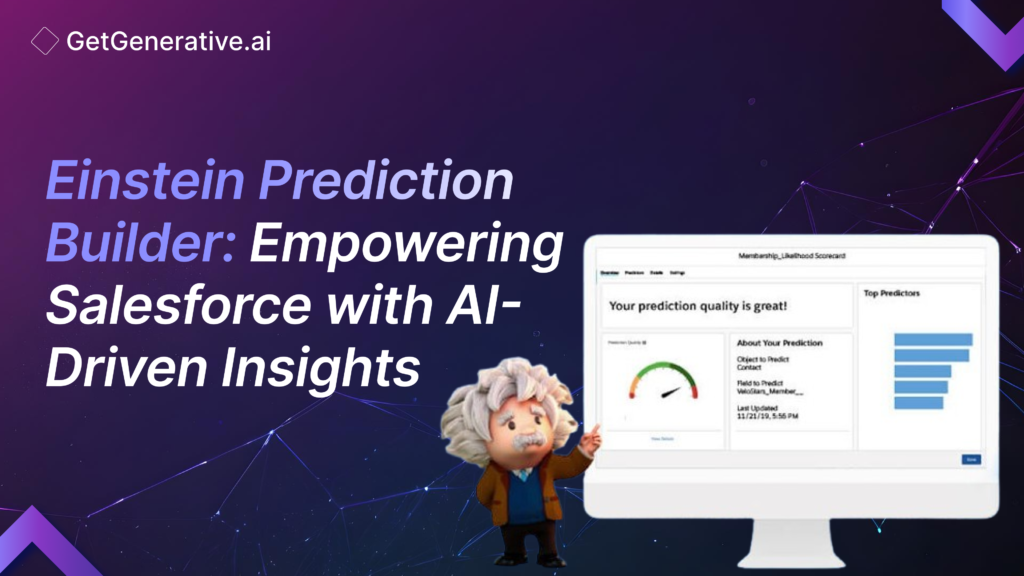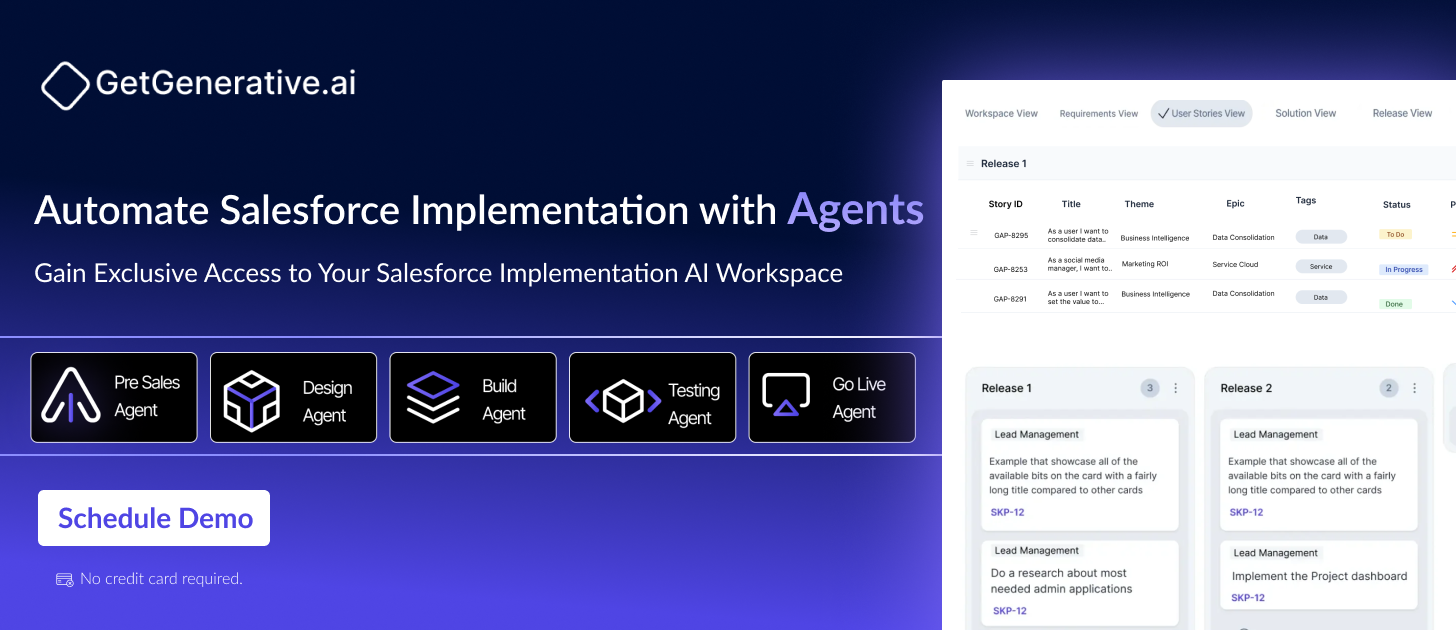Einstein Prediction Builder: Empowering Salesforce With AI-Driven Insights
Einstein Prediction Builder is an AI-powered tool within the Salesforce platform that allows users to create custom predictive models based on their unique business data.
By leveraging machine learning algorithms, Einstein Prediction Builder analyzes historical data patterns and generates accurate predictions, enabling organizations to make data-driven decisions and proactively address customer needs.
How to use Einstein Prediction Builder?
Access Einstein Prediction Builder:
- Navigate to the Einstein Prediction Builder setup page in your Salesforce org.
- Click the “New Prediction” button to create a new predictive model.
Select the Salesforce object:
- Choose the object you want to create predictions (e.g., Leads, Opportunities, Cases).
Define the outcome to predict:
- Select the field you want to predict (e.g., “Is Converted” for Leads).
Choose predictive fields:
- Select the fields in the model that may impact the predicted outcome.
- Einstein Prediction Builder suggests relevant fields, but you can customize the selection.
Specify data split:
- Determine the percentage of data to use for training and testing the model.
- The default split is 80% for training and 20% for testing, but you can adjust as needed.
Customize advanced settings:
- Set the model name description and enable automatic retraining if desired.
Train the model:
- Click on the “Build Model” button to initiate the training process.
- The training time varies based on data volume and complexity.
Evaluate model performance:
- Review the model’s performance metrics (e.g., accuracy, precision, recall).
- Use visualizations and reports to assess the model’s effectiveness.
Deploy the model:
- If satisfied with the model’s performance, deploy it to generate real-time predictions.
- Predictions will appear as a new field in the selected Salesforce object.
Leverage predictions:
- Create custom reports, dashboards, or Einstein Discovery stories incorporating the predicted outcomes.
- Use insights gained from predictions to make data-driven decisions.
Monitor and retrain:
- Regularly monitor the model’s performance to ensure continued accuracy.
- Retrain the model as needed, either automatically or manually, when data patterns change significantly.
“AI is one of the most important things humanity is working on. It is more profound than electricity or fire.”
– Sundar Pichai, CEO of Alphabet and Google
How do you create a specific model in Einstein Prediction Builder?
To create a specific model in Einstein Prediction Builder, follow these steps:
- Navigate to the Einstein Prediction Builder setup page in Salesforce.
- Click “New Prediction” and select the Salesforce object you want to predict.
- Choose the field you want to predict and specify the outcome.
- Select the fields you want to include in the model and customize the settings.
- Train the model and evaluate its performance using the provided metrics.
- Deploy the model and start generating predictions in real time.
What are the tools available for predictive analytics in Salesforce?
Salesforce offers powerful tools for predictive analytics, enabling users to gain valuable insights and make data-driven decisions. Let’s explore these tools in more detail:
Einstein Prediction Builder:
- Enables users to create custom predictive models without requiring coding skills.
- Automatically selects relevant fields and trains models based on historical data.
- Supports various Salesforce objects, such as Leads, Opportunities, and Cases.
- Provides a user-friendly interface for creating, training, and deploying models.
- Offers performance metrics and visualizations to evaluate model effectiveness.
- Allows for automatic retraining to adapt to changing data patterns.
Einstein Discovery:
- Automatically analyzes data to uncover insights, patterns, and trends.
- Generates actionable recommendations and explanations for business users.
- Supports data from multiple sources, including Salesforce and external databases.
- Provides a natural language interface for asking questions and receiving insights.
- Offers interactive visualizations and dashboards to explore and share findings.
- Enables users to create “stories” that combine insights, narratives, and recommendations.
- Integrates with Einstein Prediction Builder to enhance predictive model creation.
Also Read – Einstein Discovery: Salesforce AI Tool for Transformative Data Insights
Tableau CRM (formerly Einstein Analytics):
- Provides a comprehensive platform for advanced analytics and data visualization.
- Offers pre-built templates and dashboards for common business scenarios.
- Supports interactive exploration of data through drilling, filtering, and pivoting.
- Enables users to create custom dashboards and lenses for specific business needs.
- Integrates with Salesforce data and external data sources for a unified view.
- Provides machine learning capabilities for predictive analytics and forecasting.
- It offers collaboration features for sharing insights and working together on an analysis.
Einstein’s Next Best Action:
- Delivers personalized recommendations and actions to users within Salesforce.
- Leverages predictive models and business rules to suggest the most appropriate actions.
- Supports various use cases, such as cross-selling, upselling, and customer retention.
- Integrates with Salesforce workflows and processes for seamless execution.
- Provides a centralized hub for managing and monitoring recommendations.
Einstein Vision and Language:
- Enables image and text analysis using deep learning algorithms.
- Supports use cases like visual search, brand detection, and sentiment analysis.
- Provides pre-built models for common tasks and allows for custom model training.
- Integrates with Salesforce objects and workflows for automated actions based on insights.
Also Read – Salesforce Einstein Vision
Einstein Activity Capture:
- Automatically captures and analyzes customer interactions, such as emails and calendar events.
- Provides insights into customer behavior, preferences, and engagement patterns.
- Enables proactive outreach and personalized communication based on customer activity.
- Integrates with Salesforce data to enrich customer profiles and inform predictive models.
These tools collectively form a comprehensive predictive analytics ecosystem within Salesforce, enabling users to harness the power of AI and machine learning to drive better business outcomes. By leveraging these tools, organizations can gain a competitive edge, improve decision-making, and deliver personalized customer experiences.
It’s important to note that these tools’ availability and specific features may vary depending on the Salesforce edition and licenses an organization possesses. Salesforce regularly updates and enhances these tools to provide the most advanced and user-friendly capabilities for predictive analytics.
How do I implement Einstein Prediction Builder?
Implementing Einstein Prediction Builder involves the following steps:
- Ensure you have the necessary Salesforce editions and licenses that support Einstein Prediction Builder.
- Set up and configure Einstein Prediction Builder in your Salesforce org.
- Identify the business use case and select the appropriate Salesforce object and fields for prediction.
- Train and validate the predictive model using historical data.
- Deploy the model and integrate the predictions into your Salesforce workflows and reports.
How do you optimize models in Einstein Prediction Builder?
To optimize models in Einstein Prediction Builder, consider the following best practices:
- Ensure data quality by cleaning and preprocessing your Salesforce data.
- Select relevant fields that strongly correlate with the outcome you want to predict.
- Provide sufficient historical data for training the model (ideally, at least 1,000 records).
- Regularly monitor and retrain the model to adapt to changing data patterns and maintain accuracy.
Also Read – Top Salesforce AI Tools 2025 – The Ultimate List
What types of data are required to create predictions in Einstein Prediction Builder?
Einstein Prediction Builder works with structured data stored in Salesforce objects, including numerical, categorical, and text fields. The data should be historical and relevant to the outcome you want to predict. Examples of suitable data include lead characteristics, opportunity details, case information, and customer interactions.
Can Einstein Prediction Builder be used without extensive programming knowledge?
Yes, one of Einstein Prediction Builder’s key advantages is its user-friendly interface and ability to create predictive models without requiring extensive programming skills. The tool automates many complex data science tasks, allowing business users and Salesforce administrators to leverage the power of AI without deep technical expertise.
Conclusion
Einstein Prediction Builder is a game-changer for businesses looking to harness the power of AI within their Salesforce ecosystem. By enabling users to create custom predictive models without coding, Einstein Prediction Builder democratizes AI and empowers organizations to make data-driven decisions. With its user-friendly interface and seamless integration with Salesforce, Einstein Prediction Builder is an invaluable tool for businesses seeking to optimize their operations, improve customer experiences, and drive growth.
Visit GetGenerative.ai to explore more about Salesforce and AI.
Frequently Asked Questions (FAQs)
1. Is Einstein Prediction Builder available in all Salesforce editions?
Einstein Prediction Builder is available in Salesforce Enterprise, Performance, and Unlimited editions.
2. How long does training a predictive model in Einstein Prediction Builder take?
The training time depends on the volume and complexity of the data. It can typically range from a few minutes to a few hours.
3. Can I export the predictions generated by Einstein Prediction Builder?
Predictions can be exported as reports or integrated into Salesforce workflows and dashboards.
4. How often should I retrain my predictive models?
It is recommended that models be retrained periodically (e.g., monthly or quarterly) to ensure they remain accurate and adapt to changing data patterns.
5. Can Einstein Prediction Builder handle large datasets?
Yes, Einstein Prediction Builder can handle large datasets, but performance may vary depending on the data volume and complexity. It is recommended that you consult Salesforce documentation for best practices and limitations.




